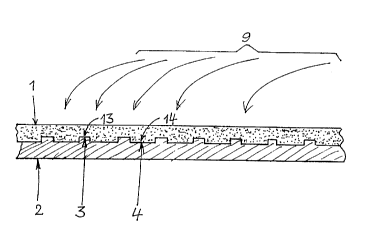Some of the information on this Web page has been provided by external sources. The Government of Canada is not responsible for the accuracy, reliability or currency of the information supplied by external sources. Users wishing to rely upon this information should consult directly with the source of the information. Content provided by external sources is not subject to official languages, privacy and accessibility requirements.
Any discrepancies in the text and image of the Claims and Abstract are due to differing posting times. Text of the Claims and Abstract are posted:
| (12) Patent: | (11) CA 2269076 |
|---|---|
| (54) English Title: | PREPARATION CONSISTING OF A SURFACE-ADHERING, FILM-LIKE OR WAFER-LIKE ADMINISTRATION FORM |
| (54) French Title: | PREPARATION CONSTITUEE D'UNE FORME D'ADMINISTRATION ADHESIVE EN SURFACE, DU TYPE FILM OU CACHET |
| Status: | Expired |
| (51) International Patent Classification (IPC): |
|
|---|---|
| (72) Inventors : |
|
| (73) Owners : |
|
| (71) Applicants : |
|
| (74) Agent: | MCCARTHY TETRAULT LLP |
| (74) Associate agent: | |
| (45) Issued: | 2003-07-08 |
| (86) PCT Filing Date: | 1997-11-04 |
| (87) Open to Public Inspection: | 1998-05-22 |
| Examination requested: | 2000-12-22 |
| Availability of licence: | N/A |
| (25) Language of filing: | English |
| Patent Cooperation Treaty (PCT): | Yes |
|---|---|
| (86) PCT Filing Number: | PCT/EP1997/006082 |
| (87) International Publication Number: | WO1998/020859 |
| (85) National Entry: | 1999-04-16 |
| (30) Application Priority Data: | ||||||
|---|---|---|---|---|---|---|
|
A preparation consisting of surface-adhering, film-like or wafer-like
administration form having a coding comprising characters and/or
graphic symbols or models to identify gustatory or odorous and/or preventive
or healing substances that are released during application is
characterized in that the coding is formed by surface sections having a
different thickness.
L'invention concerne une préparation constituée d'une forme d'administration adhésive en surface, du type film ou cachet et dotée d'un codage réalisé avec des caractères et/ou des symboles ou modèles graphiques pour identifier les substances gustatives ou odorantes et/ou préventives ou curatives qui sont libérées lors de l'utilisation de ladite préparation. L'invention est caractérisée en ce que le codage est formé par des zones plates de différentes épaisseurs.
Note: Claims are shown in the official language in which they were submitted.
Note: Descriptions are shown in the official language in which they were submitted.

For a clearer understanding of the status of the application/patent presented on this page, the site Disclaimer , as well as the definitions for Patent , Administrative Status , Maintenance Fee and Payment History should be consulted.
| Title | Date |
|---|---|
| Forecasted Issue Date | 2003-07-08 |
| (86) PCT Filing Date | 1997-11-04 |
| (87) PCT Publication Date | 1998-05-22 |
| (85) National Entry | 1999-04-16 |
| Examination Requested | 2000-12-22 |
| (45) Issued | 2003-07-08 |
| Expired | 2017-11-06 |
There is no abandonment history.
| Fee Type | Anniversary Year | Due Date | Amount Paid | Paid Date |
|---|---|---|---|---|
| Registration of a document - section 124 | $100.00 | 1999-04-16 | ||
| Application Fee | $300.00 | 1999-04-16 | ||
| Maintenance Fee - Application - New Act | 2 | 1999-11-04 | $100.00 | 1999-04-16 |
| Maintenance Fee - Application - New Act | 3 | 2000-11-06 | $100.00 | 2000-10-17 |
| Registration of a document - section 124 | $50.00 | 2000-10-25 | ||
| Request for Examination | $400.00 | 2000-12-22 | ||
| Maintenance Fee - Application - New Act | 4 | 2001-11-05 | $100.00 | 2001-10-17 |
| Maintenance Fee - Application - New Act | 5 | 2002-11-04 | $150.00 | 2002-10-17 |
| Final Fee | $300.00 | 2003-04-16 | ||
| Maintenance Fee - Patent - New Act | 6 | 2003-11-04 | $150.00 | 2003-10-20 |
| Maintenance Fee - Patent - New Act | 7 | 2004-11-04 | $200.00 | 2004-10-26 |
| Maintenance Fee - Patent - New Act | 8 | 2005-11-04 | $200.00 | 2005-10-26 |
| Maintenance Fee - Patent - New Act | 9 | 2006-11-06 | $200.00 | 2006-10-25 |
| Maintenance Fee - Patent - New Act | 10 | 2007-11-05 | $250.00 | 2007-10-23 |
| Maintenance Fee - Patent - New Act | 11 | 2008-11-04 | $250.00 | 2008-10-23 |
| Maintenance Fee - Patent - New Act | 12 | 2009-11-04 | $250.00 | 2009-10-23 |
| Maintenance Fee - Patent - New Act | 13 | 2010-11-04 | $250.00 | 2010-10-21 |
| Maintenance Fee - Patent - New Act | 14 | 2011-11-04 | $250.00 | 2011-10-21 |
| Maintenance Fee - Patent - New Act | 15 | 2012-11-05 | $450.00 | 2012-10-18 |
| Maintenance Fee - Patent - New Act | 16 | 2013-11-04 | $450.00 | 2013-10-21 |
| Maintenance Fee - Patent - New Act | 17 | 2014-11-04 | $450.00 | 2014-10-24 |
| Maintenance Fee - Patent - New Act | 18 | 2015-11-04 | $450.00 | 2015-10-26 |
| Maintenance Fee - Patent - New Act | 19 | 2016-11-04 | $450.00 | 2016-10-25 |
Note: Records showing the ownership history in alphabetical order.
| Current Owners on Record |
|---|
| LTS LOHMANN THERAPIE-SYSTEME AG |
| Past Owners on Record |
|---|
| LTS LOHMANN THERAPIE-SYSTEME GMBH |
| LUDWIG, KARIN |